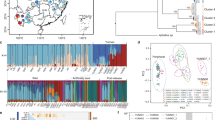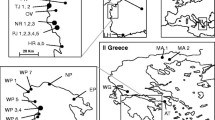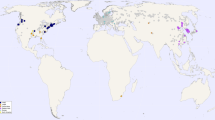Abstract
Rhopalosiphun padi is a pest that seriously devastates wheat crops. The life cycle, genetic diversity, and genetic structure of R. padi populations throughout China remain unclear. In the current study, we collected 17 R. padi populations throughout the wheat-growing region of China. Classical standard methods were used to determine the life cycles of 369 clones from the sampled populations. Five polymorphic microsatellite loci were used to genotype individuals from each clone. The results revealed that two populations from spring wheat-growing regions showed cyclical parthenogenesis, whereas 15 populations from winter wheat-growing regions showed obligate parthenogenesis. There was a significant genetic difference between populations with obligate parthenogenesis and populations with cyclical parthenogenesis. Populations with cyclical parthenogenesis did not show significant departures from Hardy–Weinberg equilibrium, whereas all populations with obligate parthenogenesis exhibited significant departures from Hardy–Weinberg equilibrium. Significant genetic structures were found in the populations. Two R. padi populations with cyclical parthenogenesis showed similar genetic structures, two populations from a subtropical plateau had similar genetic structures, and the populations sampled in the large winter wheat-growing regions in northern and central China showed similar genetic structures. There was a significant isolation-by-distance effect present among different populations. To the best of our knowledge, this is the first documentation of the life cycle and population genetic of R. padi in China. Our results are important for the design and optimization of sustainable pest management strategies.






Similar content being viewed by others
References
Arnaud-Haond S, Belkhir K (2007) GENCLONE: a new program to analyse genetics data on clonal organisms. Mol Ecol Notes 7:15–17
Balloux F, Lehmann L, de Meeus T (2003) The population genetics of clonal and partially clonal diploids. Genetics 164(4):1635–1644
Barton NH, Charlesworth B (1998) Why sex and recombination? Science 281(5385):1986–1990
Bengtsson BO (2003) Genetic variation in organisms with sexual and asexual reproduction. J Evol Biol 16(2):189–199
Blackman RL (1971) Variation in the photoperiodic response within natural populations of Myzus persicae Sulz. Bull Entomol Res 60(4):533–546
Blackman RL (1974) Life cycle variation of Myzus persicae (Sulz.) (Hom., Aphididae) in different parts of the world, in relation to genotype and environment. Bull Entomol Res 63(4):595–607
Blackman RL, Eastop VF (2000) Aphids on the world’s crops: An identification and information guide, 2nd edn. Wiley, London
Bonnet E, Van der Peer Y (2002) ZT: a software tool for simple and partial Mantel tests. J Stat Softw 7(10):1–12
Cardé RT, Minks AK (1995) Control of moth pests by mating disruption: successes and constraints. Ann Rev Entomol 40:559–585
Chapuis MP, Estoup A (2007) Microsatellite null alleles and estimation of population differentiation. Mol Biol Evol 24(3):621–631
Chen MH, Dorn S (2010) Microsatellites reveal genetic differentiation among populations in an insect species with high genetic variability in dispersal, the codling moth, Cydia pomonella (L.) (Lepidoptera: Tortricidae). Bull Entomol Res 100(1):75–85
Chen MH, Han ZJ, Qiao XF, Qu MJ (2007a) Resistance mechanisms and associated mutations in acetylcholinesterase genes in Sitobion avenae (Fabricius). Pestic Biochem Phys 87(3):189–195
Chen MH, Han ZJ, Qiao XF, Qu MJ (2007b) Mutations in acetylcholinesterase genes of Rhopalosiphum Padi resistant to organophosphate and carbamate insecticides. Genome 50(2):172–179
Danjuma S, Thaochan N, Permkam S, Satasook C (2014) Effect of temperature on the development and survival of immature stagets of the carambola fruit fly, Bactrocera carambolae, and the Asian papaya fruit fly, Bactrocera papayae, reared on guava diet. J Insect Sci 14:126
Dedryver CA, Le Gallic JF, Gauthier JP, Simon JC (1998) Life cycle of the aphid Sitobion avenae F. polymorphism associated with sexuality. Ecol Entomol 23:123–132
Dedryver CA, Hullé M, Le Gallic JF, Caillaud MC, Simon JC (2001) Coexistence in space and time of sexual and asexual populations of the cereal aphid Sitobion avenae. Oecologia 128(3):379–388
Delmotte F, Leterme N, Bonhomme J, Rispe C, Simon JC (2001) Multiple routes to asexuality in an aphid species. Proc Roy Soc Lond B Biol Sci 268(1483):2291–2299
Delmotte F, Leterme N, Gauthier JP, Rispe C, Simon JC (2002) Genetic architecture of sexual and asexual populations of the aphid Rhopalosiphum padi based on allozyme and microsatellite markers. Mol Ecol 11(4):711–723
Dieringer D, Schlotterer C (2003) MICROSATELLITE ANALYSER (MSA): a platform independent analysis tool for large microsatellite data sets. Mol Ecol Notes 3(1):167–169
Dixon AFG (1998) Aphid ecology: an optimization approach, 2nd edn. Blackie and Son Ltd, London
Doncaster CP, Pound GE, Cox SJ (2000) The ecological cost of sex. Nature 404(6775):281–285
Earl DA, Vonholdt BM (2012) STRUCTURE HARVESTER: a website and program for visualizing STRUCTURE output and implementing the Evanno method. Conserv Genet Resour 4(2):359–361
Evanno G, Regnaut S, Goudet J (2005) Detecting the number of clusters of individuals using the software STRUCTURE: a simulation study. Mol Ecol 14(8):2611–2620
Excoffier L, Lischer HEL (2010) Arlequin suite ver 3.5: A new series of programs to perform population genetics analyses under Linux and Windows. Mol Ecol Resour 10(3):564–567
Fenton B, Malloch G, Navajas M, Hillier J, Birch ANE (2003) Clonal composition of the peach-potato aphid Myzus persicae (Homoptera: Aphididae) in France and Scotland: Comparative analysis with IGS fingerprinting and microsatellite markers. Ann Appl Biol 142(3):255–267
Fenton B, Kasprowicz L, Malloch G, Pickup J (2010) Reproductive performance of asexual clones of the peach-potato aphid,(Myzus persicae, Homoptera: Aphididae), colonising Scotland in relation to host plant and field ecology. Bull Entomol Res 100(4):451–460
Gilabert A, Simon JC, Mieuzet L, Halkett F, Stoeckel S, Plantegenest M, Dedryver CA (2009) Climate and agricultural context shape reproductive mode variation in an aphid crop pest. Mol Ecol 18(14):3050–3061
Goudet J (2002). FSTAT Version 2.9.3.2 for windows: a computer program to calculate F-statistics. http://www2.unil.ch/popgen/softwares/fstat. Accessed August 23 2005
Guillemaud T, Mieuzet L, Simon JC (2003) Spatial and temporal genetic variability in French populations of the peach-potato aphid, Myzus persicae. Heredity 91(2):143–152
Halkett F, Simon JC, Balloux F (2005) Tackling the population genetics of clonal and partially clonal organisms. Trends Ecol Evol 20(4):194–201
Halkett F, Plantegenest M, Bonhomme J, Simon JC (2008) Gene flow between sexual and facultatively asexual lineages of an aphid species and the maintenance of reproductive mode variation. Mol Ecol 17(12):2998–3007
Hamilton WD (1980) Sex versus non-sex versus parasite. Oikos 35:282–290
He FG, Wang YQ, Yan FY, Zhang J (1994) The preliminary invesitigation of Rhopalosiphum padi (L.) overwinter in Shenyang region. Liaoning Agri Sci 6:46–48
Ivey CT, Richards JH (2001) Genetic diversity of everglades sawgrass, Cladium jamaicense (Cyperaceae). Int J Plant Sci 162:817–825
Kanbe T, Akimoto SI (2009) Allelic and genotypic diversity in long-term asexual populations of the pea aphid, Acyrthosiphon pisum in comparison with sexual populations. Mol Ecol 18(5):801–816
Kondrashov AS (1988) Deleterious mutations and the evolution of sexual reproduction. Nature 336:435–440
Krascsenitsová E, Kozánek M, Ferenčík J, Roller L, Stauffer C, Bertheau C (2013) Impact of the Carpathians on the genetic structure of the spruce bark beetle Ips typographus. J Pest Sci 86(4):669–676
Loxdale HD (2008) The nature and reality of the aphid clone: genetic variation, adaptation and evolution. Agri Forest Entomol 10(2):81–90
Lu YH, Gao XW (2009) Multiple mechanisms responsible for differential susceptibilities of Sitobion avenae (Fabricius) and Rhopalosiphum padi (Linnaeus) to pirimicarb. Bull Entomol Res 99(6):611–617
Luo RW, Yang CL, Shang YF, Li CS, Zhao JH (1994) Overwinter of and migration of Rhopalosiphum padi. Entomol J East China 3(1):43–47
Lynch M (1984) Destabilizing hybridization, general-purpose genotypes and geographic parthenogenesis. Q Rev Biol 59:257–290
Lyons JI, Pierce AA, Barribeau SM, Sternberg ED, Mongue AJ, Roode J (2012) Lack of genetic differentiation between monarch butterflies with divergent migration destinations. Mol Ecol 21(14):3433–3444
Mantel N (1967) The detection of disease clustering and a generalized regression approach. Cancer Res 27:209–220
Margaritopoulos JT, Tsitsipis JA, Goudoudaki S, Blackman RL (2002) Life cycle variation of Myzus persicae (Hemiptera: Aphididae) in Greece. B Entomol Res 92(4):309–319
Maynard Smith J (1978) The evolution of sex. Cambridge University Press, Cambridge
Miller NJ (2000) Population structure and gene flow in a host alternating aphid, Pemphigus bursarius. Dissertation, University of Birmingham
Normark BB (1999) Evolution in a putatively ancient asexual aphid lineage: recombination and rapid karyotype change. Evolution 53(5):1458–1469
Paland S, Colbourne JK, Lynch M (2005) Evolutionary history of contagious asexuality in Daphnia pulex. Evolution 59(4):800–813
Papura D, Simon JC, Halkett F, Delmotte F, Le Gallic JF, Dedryver CA (2003) Predominance of sexual reproduction in Romanian populations of the aphid Sitobion avenae inferred from phenotypic and genetic structure. Heredity 90(5):397–404
Parry HR, Evans AJ, Morgan D (2006) Aphid population response to agricultural landscape change: a spatially explicit, individual-based model. Ecol Model 199(4):451–463
Peck JR (1994) A ruby in the rubbish-beneficial mutations, deleterious mutations and the evolution of sex. Genetics 137(2):597–606
Peck JR, Yearsley JM, Waxman D (1998) Explaining the geographic distributions of sexual and asexual populations. Nature 391(6670):889–892
Pritchard JK, Stephens M, Donnelly P (2000) Inference of population structure using multilocus genotype data. Genetics 155(2):945–959
Provan J, Glendinning K, Kelly R, Maggs CA (2013) Levels and patterns of population genetic diversity in the red seaweed Chondrus crispus (Florideophyceae): a direct comparison of single nucleotide polymorphisms and microsatellites. Biol J Linn Soc 108(2):251–262
Rispe C, Pierre JS (1998) Coexistence between cyclical parthenogens, obligate parthenogens and intermediates in a fluctuating environment. J Theor Biol 195(1):97–110
Rispe C, Pierre JS, Simon JC, Gouyon PH (1998) Models of sexual and asexual coexistence in aphids based on constraints. J Evol Biol 11(6):685–701
Rosenberg NA (2004) DISTRUCT: a program for the graphical display of population structure. Mol Ecol Notes 4(1):137–138
Rousset F (2008) Genepop’007: a complete re-implementation of the genepop software for Windows and Linux. Mol Ecol Resour 8(1):103–106
Ryman N, Palm S (2006) POWSIM: a computer program for assessing statistical power when testing for genetic differentiation. Mol Ecol 6(3):600–602
Sandrock C, Razmjou J, Vorburger C (2011) Climate effects on life cycle variation and population genetic architecture of the black bean aphid, Aphis fabae. Mol Ecol 20(19):4165–4181
Schlotterer C (2000) Evolutionary dynamics of microsatellite DNA. Chromosoma 109(6):365–371
Schuelke M (2000) An economic method for the fluorescent labeling of PCR fragments. Nat Biotechnol 18(2):233–234
Shabani M, Bertheau C, Zeinalabedini M, Sarafrazi A, Mardi M, Naraghi SM, Rahimian H, Shojaee M (2013) Population genetic structure and ecological niche modelling of the leafhopper Hishimonus phycitis. J Pest Sci 86(2):173–183
Simon JC, Blackman R, Le Gallic JF (1991) Local variability in the life cycle of the bird cherry-oat aphid, Rhopalosiphum padi (Homoptera: Aphididae) in western France. B Entomol Res 81(3):315–322
Simon JC, Carrel E, Hebert PDN, Dedryver CA, Bonhomme J, Le Gallic JF (1999a) Genetic diversity and mode of reproduction in French population of the aphid Rhopalosiphum padi L. Heredity 76:305–313
Simon JC, Baumann S, Sunnucks P, Pierre JS, Le Gallic JF, Dedryver CA (1999b) Reproductive mode and population genetic structure of the cereal aphid Sitobion avenae studied using phenotypic and microsatellite markers. Mol Ecol 8(4):531–545
Simon JC, Leterme N, Delmotte F, Martin O, Estoup A (2001) Isolation and characterization of microsatellite loci in the aphid species, Rhopalosiphum padi. Mol Ecol Notes 1(1):4–5
Simon JC, Rispe C, Sunnucks P (2002) Ecology and evolution of sex in aphids. Trends Ecol Evol 17(1):34–39
Simon JC, Delmotte F, Rispe C, Crease T (2003) Phylogenetic relationships between parthenogens and their sexual relatives: the possible routes to parthenogenesis in animals. Biol J Linn Soc 79(1):151–163
Stenberg P, Lundmark M, Saura A (2003) MLGsim: a program for detecting clones using a simulation approach. Mol Ecol Notes 3(2):329–331
Sunnucks P, England PR, Taylor AC, Hales DF (1996) Microsatellite and chromosome evolution of parthenogenetic Sitobion aphids in Australia. Genetics 144(2):747–756
Sunnucks P, De Barro PJ, Lushai G, Maclean N, Hales DF (1997) Genetic structure of an aphid studied using microsatellites: cyclic parthenogenesis, differentiated lineages and host specialization. Mol Ecol 6(11):1059–1073
Takezaki N, Nei M (1996) Genetic distances and reconstruction of phylogenetic trees from microsatellite DNA. Genetics 144(1):389–399
Tamura K, Peterson D, Peterson N, Stecher G, Nei M, Kumar S (2011) MEGA5: molecular evolutionary genetics analysis using maximum likelihood, evolutionary distance, and maximum parsimony methods. Mol Bio Evol 28(10):2731–2739
Torriani MVG, Mazzi D, Hein S, Dorn S (2010) Structured populations of the oriental fruit moth in an agricultural ecosystem. Mol Ecol 19(13):2651–2660
Valenzuela I, Ridland PM, Weeks AR, Hoffmann AA (2010) Patterns of genetic variation and host adaptation in an invasive population of Rhopalosiphum padi (Hemiptera: Aphididae). Ann Entomol Soc Am 103(6):886–897
van Emden HF, Harrington R (2007) Aphids as crop pests. CABI, Oxford
Van Oosterhout C, Hutchinson WF, Wills DP, Shipley P (2004) MICRO-CHECKER: software for identifying and correcting genotyping errors in microsatellite data. Mol Ecol Notes 4(3):535–538
Vandel A (1928) La parthénogenèse géographique. Contribution à l’étude biologique et cytologique de la parthénogenèse naturelle. B Biol de la Fran et de la Belg 62:164–281
Vorburger C, Lancaster M, Sunnucks P (2003) Environmentally related patterns of reproductive modes in the aphid Myzus persicae and the predominance of two ‘superclones’ in Victoria, Australia. Mol Ecol 12(12):3493–3504
Vorwerk S, Forneck A (2006) Reproductive mode of grape phylloxera (Daktulosphaira vitifoliae, Homoptera: Phylloxeridae) in Europe: molecular evidence for predominantly asexual populations and a lack of gene flow between them. Genome 49(6):678–687
Wang YM (2007) Molecular evidence of population genetic structure, migration and reproductive mode of Sitobion avenae (Fabricius) in China. Dissertation, China Agriculture University
Weir BS, Cockerham CC (1984) Estimating F-statistics for the analysis of population structure. Evolution 38(6):1358–1370
Wilson ACC, Sunnucks P, Hales DFH (1999) Microevolution, low clonal diversity and genetic affinities of parthenogenetic Sitobion aphids in New Zealand. Mol Ecol 8(10):1655–1666
Wöhrmann K, Tomiuk J (1988) Life cycle strategies and genotypic variability in populations of aphids. J Genet 67(1):43–52
Zhang JY (1990) The plum and apricot resources in China. China Fruits 4:29–34
Zhang XC, Zhou GH, Shi M, Fang JZ, Zhao ZP, Li SH, Dong QZ, Wei K (1985) The rules of long distance migration and virus transmission of wheat aphids. J Plant Prot 12(1):9–16
Zhang DX, Yan LN, Ji YJ, Hewitt GM, Huang ZS (2009) Unexpected relationships of substructured populations in Chinese Locusta migratoria. BMC Evol Biol 9(1):144
Zheng Y, Peng X, Liu GM, Pan HY, Dorn S, Chen MH (2013) High genetic diversity and structured populations of the oriental fruit moth in its range of origin. PLoS One 8(11):e78476
Acknowledgments
This work was funded by the National Natural Science Foundation of China (Grants Nos. 31272036, 31471766), the Doctoral Program Foundation of Institutions of Higher Education of China (20110204110001), and the National Key Technology R&D Program of the Ministry of Science and Technology of China (2012BAK11B03). We thank Huimin Shen, Jin Huang, Geng Tao, Lijun Chen, Yunzhuan He, Shuxia Tao, Changchun Dai, Changyou Li and JinhuaYang for their help with the collection of Rhopalosiphum padi samples.
Author information
Authors and Affiliations
Corresponding author
Additional information
Communicated by B. Lavandero.
Xinle Duan and Xiong Peng contributed equally to this work.
Rights and permissions
About this article
Cite this article
Duan, X., Peng, X., Qiao, X. et al. Life cycle and population genetics of bird cherry-oat aphids Rhopalosiphum padi in China: an important pest on wheat crops. J Pest Sci 90, 103–116 (2017). https://doi.org/10.1007/s10340-016-0752-9
Received:
Revised:
Accepted:
Published:
Issue Date:
DOI: https://doi.org/10.1007/s10340-016-0752-9




